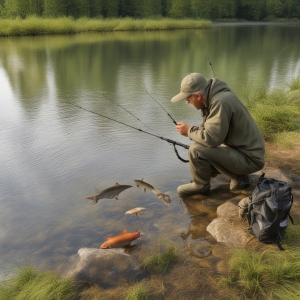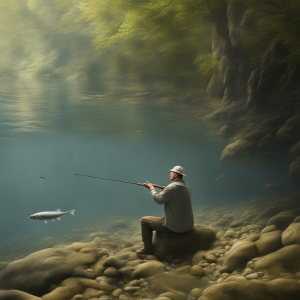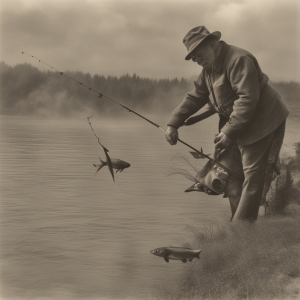Table of Contents:
So, you're sat by the water's edge, rod in hand, wondering why the fish just aren't biting? Welcome to the world of angling – a pastime as much about patience as it is about skill. But, what if I told you there's a way to unlock the secrets of fish behavior, boosting your chances of a successful catch? In this article, we at Buzzerfish are diving deep into the realm of apricot practices, sharing our insights in a comprehensive guide on decoding fish behavior. This guide aims to share with you the top strategies to 'crack the code' of fish behavior and secure a successful catch every time.
Introduction to Deciphering Fish Behavior
The foundation to any effective fishing strategy lies in understanding the behavior of your target species. From recognizing their feeding habits, to knowing where they are likely to be hiding, each element of their behavior can prove key to a successful catch. The role of this section is to introduce you to the basic principles of decoding fish behavior. Albeit, we must warn you - no two species are alike, and their behavior can be shaped by various factors such as temperature, weather, and time of year.
For any angler, beginner or experienced, understanding fish behavior is like decrypting a secret language. A correct interpretation can turn a quiet day at the lake into a very exciting fishing adventure. That being said, where should one start? Let's dive in.
Understanding Fish Behavior
So, let's break down the basics of fish behavior. Believe it or not, fish are creatures of habit. They follow certain patterns and routines daily, which can mean good news for us anglers. Understanding these patterns can lead to a more successful and enjoyable fishing experience.
One important aspect is their feeding habits. Most fish have very specific diets and feeding times. For instance, some species are most active during dawn or dusk, which is when food is most available. Others might feed best in cooler or warmer waters. So, knowing what your target fish eats, when and where, can be a game-changer.
Another key aspect is their habitat. Each species has a preferred environment where they feel safest or that provides the best access to food. Shallow waters, deep waters, rocky areas, or water vegetation are examples of places that different types of fish might call home. Again, being aware of these preferences can help you locate your target more easily.
And then there's the weather. Fish behavior can change with weather conditions. Some fish might move deeper during high temperatures, while others come closer to the surface when it's cooler. Observing the weather and understanding its effects can make your fishing trips much more productive.
To summarize, you can learn a lot about fish from observing their behavior. Nature gives hints, and it's our mission to interpret and act upon them. After all, fishing is more than just luck. It's about knowing what to look for and when to look for it.
Pros and Cons of Decoding Fish Behavior
| Pros | Cons |
|---|---|
| Improved understanding of marine ecosystems | Difficulties in interpreting data gathered |
| Potential advancements in conservation efforts | Can be time-consuming and expensive |
| Possibility of finding new fish species | Lack of standard methodologies for behavior studies |
| Contributions to fields such as neurology and psychology | Ethical concerns may arise regarding fish handling |
Strategies for Studying Fish Behavior

If you've understood the importance of knowing fish behavior, the next step is learning effective strategies to study it. Here's where research and observation come in.
Start your study with a little research. Read up on the fish species you are aiming to catch. Learn about their diet, habitat, and response to temperature and weather conditions. Get familiar with their mating habits and spawning periods as these can greatly affect their behavior.
After conducting your research, it's time for some field observation. Spend some time by the water and observe the fish's behavior firsthand. Pay attention to their feeding times, their favored spots, and their response to changes in weather. Note that this observation process may require repeat visits, and might even span across different seasons.
Consider keeping a fishing journal. In it, write down the conditions under which you've had successful catches. Include details like weather, time, location, and bait used. Over time, you'll start seeing patterns that you can leverage on your future fishing trips.
Finally, don't underestimate the power of local knowledge. Chat with other anglers and fishing enthusiasts in the area. You can learn a lot from their experiences and tips, especially if they've been fishing locally for a long time.
Interpreting Fish Behavior While Fishing
Now that we've armed you with some essential knowledge, let's go deeper by exploring how to interpret fish behavior when you're out there by the water. This can be the real game-changer in your angling adventures.
Start by watching the water. Look for signs of fish activity such as splashes, jumping fish, or ripples that don’t have a clear cause. These could be indicators that there are fish feeding or traveling on or below the surface. Take notice of bird activity, too, as many birds feed on the same smaller fish that larger fish prey upon, indicating a possible hot spot.
But don't just trust your eyes; use your ears, too. Fish jumping out of the water, subtle splashes, or the fluttering of wings can all signal the presence of fish.
Often overlooked, the sense of touch can make a world of difference. Pay attention to the smallest tug or vibration on your fishing line. Challenge yourself to hold still and feel any unusual movement - it could be that a fish is carefully investigating your bait.
Furthermore, technology can be our friend. Today's anglers can have access to sophisticated fish finders and sonar technology that can pretty much map out where the fish are hiding underwater. These tools not only help you find the fish but also give you rare insights into their movements and patterns.
Lastly, patience plays a key part. Remember that fish are unpredictable, and interpreting their behavior can take time and practice. Keep refining your observation and interpretation skills, and don’t be disheartened if things don’t immediately go your way.
Insights from Experienced Anglers

Seeking advice from seasoned anglers is an incredibly valuable strategy in deciphering fish behavior. Experienced anglers have the benefit of time spent and lessons learned out in the water. They can provide unique insights that you won’t find in guide books or online articles.
Seasoned anglers often know the best spots for catching specific species. Their knowledge about the best baits and lures, the ideal casting spots, or the most effective time of day for angling, can make a big difference in your fishing experience.
Take the time to connect with local fishing communities. Whether it’s a fishing club or an online forum, actively engage in conversations. Ask questions about specific fishing locations or strategies. You can learn valuable nuggets of wisdom to enhance your angling skills.
Another great way to gain insights is by spending a day on the water with a more experienced angler. Watching firsthand how he or she reads the water and adapts to changing conditions can be highly informative.
In addition, attending fishing workshops or angling courses can also be a fruitful way to gain more knowledge about fish behaviour. Such programmes often cover a range of useful topics such as interpreting water conditions, understanding fish migration patterns, and using the correct gear, to name a few.
In conclusion, it might seem daunting at first, but remember - every expert was once a beginner. Be patient, stay curious, and keep learning. The language of fish might be complex, but cracking the code is an exciting challenge that every angler can enjoy.
Practical Tips to Decode Fish Habits
With foundations built, let's dive into some practical tips to crack the code and gain more insight into fish behavior:
1. Scientific Study: Grasp the basics of fish biology. An understanding of how fish see, smell and hear can provide invaluable insights. Certain types of bait may be more attractive depending on their color, smell or the sound they make in the water. Additionally, understanding fish lifecycle phases (spawning period, for instance) can give clues to their behavior.
2. Observe Nature: The behavior of birds, insects, and even the water itself can sometimes hint at what is happening beneath the surface. Schools of bait fish could indicate the presence of predatory game fish nearby. Similarly, birds diving into the water can be a sign of high fish activity in that area. Observing nature's signals can guide you to those key fishing spots!
3. Use Your Gear Wisely: Your fishing gear is a powerful ally when trying to understand fish behavior. A fish finder or underwater camera can give you a direct look at what’s happening beneath the surface, offering live feedback that can help you figure out how fish are reacting to your bait or lure.
4. Follow Fish Trails: Fish tend to follow the same routes or paths year after year. These trails can lead to specific feeding or breeding spots. If you can figure out these trails, you can predict where the fish may be at specific times.
5. Be Versatile: Do not be afraid to try new strategies. If what you're doing is not working, change it up. Try different baits, different spots, different depths, or even different times of the day. It’s all about learning and adapting to secure a successful catch.
At day's end, decoding fish behavior is about combining knowledge, observation, and plenty of experience. So don't cut your fishing trip short - the more time you spend on the water, the more you learn about the mysterious world beneath the surface.
The Role of Patience and Observation

Real proficiency in angling isn't all about having the fanciest gear or the most enticing bait, it's about cultivating the art of patience and observation. Both patience and observation play pivotal roles in understanding fish behavior and improving your angling success.
Patience is your best ally and can often distinguish a successful and unsuccessful angler. This virtue enables you to persist when the fish aren't biting, and to keep trying different techniques until you find what works. Furthermore, patience allows you to wait for the perfect moment, rather than rush and potentially scare away your target. Remember, fishing is not a fast-paced sport: it's an activity that rewards those willing to wait.
On the other hand, observation fuels learning about the underwater world. By closely observing the water body's condition, the feeding patterns, preferred habitats, migration patterns, and weather's impact, you can accrue significant insights into fish behavior. This process isn't immediate; it may need repeated trips and consistent attention to unravel the collected findings. To aid in this process, you can make use of a fishing journal, documenting your observations and using them as reference for future fishing pursuits.
So, the next time you go fishing, make sure you pack an extra dose of patience and careful observation along with your fishing gear. By combining these qualities with your growing knowledge of fish behavior, you're bound to make every fishing trip an exciting adventure.
Conclusion: Mastering Fish Behavior
Grasping the subtle science of fish behavior is a skill that can take your angling game to the next level. By spending time understanding their feeding habits, preferred habitats, and responses to different weather conditions, you are not just becoming a more proficient angler, but also developing an appreciation for the dynamic and complex world beneath the water's surface.
Through research, careful observation, maintaining a fishing journal, and tapping into local knowledge, you can cultivate a finesse for reading signs of fish activity that could help you plot your next fishing adventure. Remember that each species has unique behavioral patterns, and factors like weather, time of year, and local conditions can trigger variations.
This journey to mastering fish behavior is as exciting as it is rewarding. Because when you throw your line into the water knowing you've cracked the secret language of the fishes, each expedition can unfold like a well-plotted adventure. Who said fishing was just about luck! So, get started, study your fish, and let their behavior be your guide to ultimate fishing success.
FAQ on Decoding Fish Behavior
What triggers fish behavior?
Fish behavior is predominantly influenced by environmental factors such as temperature, lighting conditions, water chemistry, and the availability of food and shelter.
How can fish behavior be studied?
Fish behavior can be studied through practices such as observation in natural habitats, laboratory experiments, and by using tracking technologies.
What is schooling behavior in fish?
Schooling is a survival behavior displayed by many fish species where they swim in a coordinated manner in large groups. This behavior offers protection against predators and aids in foraging.
Why do fish exhibit spawning behavior?
Spawning behavior in fish is essentially a part of their reproduction process. Fish exhibit different behaviors to attract mates and protect their eggs and offspring.
What factors affect aggressive behavior in fish?
Factors that may trigger aggression in fish include competition for resources, territorial disputes, and the presence of predators.







